
Series B
The Passion Story - Gospel Analysis
Part 3: Trials before Caiaphas, Pilate, Herod. Barabbas.
Mark 14:53-15:1-14
The following Bible study is from a larger course entitled, THE LIFE OF CHRIST: A Study in the Four Gospels. This 54 week course for the laity will be available for congregations in 2006.
Basic text for the course: SYNOPSIS OF THE FOUR GOSPELS, Kurt Aland, English Edition, P. 276-324.
#332. Jesus Before The Sandhedrin (Peter's Denial),
Also #333
Matthew 26:57-68, Mark 14:53-65, Luke 22:54-71, John 18:13-24
The following story is a harmonization of the four accounts from Matthew, Mark, Luke and John. In our basic text, SYNOPSIS OF THE FOUR GOSPELS, the progression of the story flows from:
- John 18:13-24 to
- Luke 22:54-71 to
- Mark 14:55-61 to
- John 18:13-24 to
- Mark 14:61b-65
-First they took him to Annas, who was the father-in-law of Caiaphas, the high priest that year. Caiaphas was the one who had advised the Jews that it was better to have one person die for the people. (only John) See Matthew who also names Caiaphas as being the high priest.
Annas and Caiaphas were the most powerful Jewish leaders in Israel at the time of Christ. They were a family dynasty that ruled for thirty years, from 6 CE to 36 CE; from the time Jesus was a boy of twelve until after Jesus died. Annas had four sons and one son-in-law, and they all became High Priests. It was a High Priestly family. The one son-in-law was Joseph Caiaphas. Joseph Caiaphas was High Priest for eighteen years; he was a shrewd and masterful politician. This family, especially Annas and Caiaphas, ruled the nation in collusion with the Romans for thirty years. Some scholars speculate that Annas and Caiaphas lived in two different wings of the same house.
-They took Jesus to the high priest’s house. Luke tells us that they went to the house of the high priest.
Below: The home of Caiaphas was where informal meetings of the Sanhedrin were held. Peter denied Jesus in a courtyard similar to the courtyard pictured below. The model of Caiahas’ house and its courtyards can be seen at the Holy Land Hotel in Jerusalem. This model is a scholar's conception of how the site may have looked in Jesus' day.
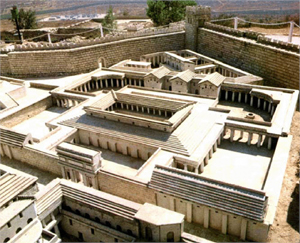
Palace of Caiaphas
In the map below, find the location of the house of Joseph Caiaphas. It was located in the Upper City.
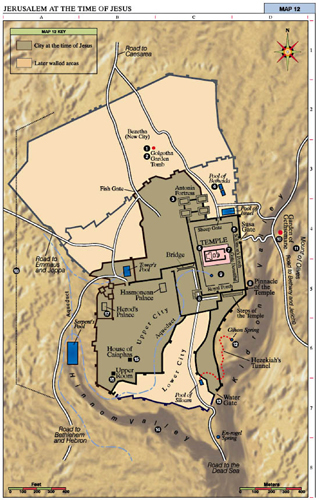
Today, we can find valuable information about the high priest. Amazingly, archeologists have found his ossuary or “bone box” that housed Caiaphas’ bones from the first century.
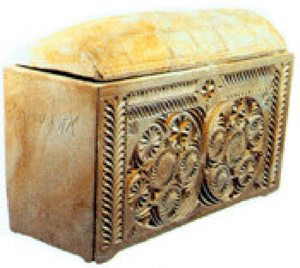
This ossuary of Caiaphas was discovered in Jerusalem by archaeologists. It was carved from limestone and bears the name "Caiaphas", the name of the Temple High Priest during the time of Christ. Ossuaries were typically used to hold the bones of the dead.”
-And all the chief priests, the elders, and the scribes were assembled. The religious “big wigs” were there to set the stage for Jesus’ execution.
-Peter had followed him at a distance, right into the courtyard of the high priest; and he was sitting with the guards, warming himself at the fire. Peter was keeping his safe distance and anonymity. We can visualize Peter coming into the courtyard of the house and sitting with a group of guards and warming himself by the fire. The scene is easily visualized and has inspired painters through the centuries. We will see such paintings shortly.
-Simon Peter and another disciple followed Jesus. Since that disciple was known to the high priest, he went with Jesus into the courtyard of the high priest, but Peter was standing outside at the gate. So the other disciple, who was known to the high priest, went out, spoke to the woman who guarded the gate, and brought Peter in. (only John) Most scholars say that “the other disciple” was John himself, the author of the Gospel of John. John was an eyewitness. John is a source of many of the juicy details about Jesus’ life e.g. this scene about Peter and the campfire outside of the home of Caiaphas. We recall three other references to “the other disciple” e.g. John 20:2: “She (Mary Magdalene) ran and went to Simon Peter and the other disciple, the one whom Jesus loved.” We recall John 21:7: “The disciple whom Jesus loved said to Peter.” John 21:20: “Peter turned and saw the disciple whom Jesus loved following them; he was the one who had reclined next to Jesus at the supper and had said, ‘Lord, who is going to betray you?’ The author, John, leaves his identifying mark on this particular story about Caiaphas’ courtyard by his intricately detailed description of this scene.
-The woman said to Peter, ‘You are not also one of this man’s disciples, are you?’ He said, ‘I am not.’ For some unknown reason, the woman at the door to the courtyard thought Peter was a disciple of Jesus. Peter begins his process of denial. We, like Peter, pretend that we do not know Jesus. We, like Peter, pretend that we are not his disciples. We cover it up, not mention it, and avoid such topics. There is safety in silence and Peter wanted to be safely silent.
-Now the slaves and the police had made a charcoal fire because it was cold, and they were standing around it and warming themselves. Peter also was standing with them and warming himself. Notice the detail of the charcoal fire. Shortly, we will see paintings of this scene which is graphic and easily visualized. Later, in John 21:9, at the resurrection appearance of Jesus, we will again encounter a charcoal fire. It is interesting that both charcoal fires are associated with Peter.
-Then a servant-girl, seeing him in the firelight, stared at him and said, ‘This man also was with him.’ We momentarily focus on the phrase, “stared at him,” and sense that we are reading an eyewitness account, a memory that was deep in John’s personal recollections of the past.
-But he denied it, saying, ‘Woman, I do not know him.’ Yes, there are times in our Christian lives that we deny that we know him, that we are his disciples.
-A little later someone else, on seeing him, said, ‘You also are one of them.’ But Peter said, ‘Man, I am not!’ John gives us a graphic accounting of what happened near the campfire that night. There was the second person who identified Peter as a disciple, but Peter again denied his relationship with Jesus.
-Then about an hour later still another kept insisting, ‘Surely this man also was with him; for he is a Galilean.’ But Peter said, ‘Man, I do not know what you are talking about!’ John continues to give us a blow-by-blow description of the scene that night. An hour goes by and a third person insists that “this man” was a Galilean. Peter could have revealed that he was a Galilean by his accent, an accent by a man from Galilee. People often know the identity of someone else by their accent, and Peter’s accent revealed that he indeed was a Galilean.
-At that moment, while he was still speaking, the cock crowed. This event became a powerful symbol in the life of the church. The crow of the rooster symbolizes the moment when people in the Church realize their/our denial of Jesus.
-The Lord turned and looked at Peter. (only Luke). This is a good detail. As we deny Christ, Christ looks directly into our eyes and we know we cannot escape his gaze.
-Then Peter remembered the word of the Lord, how he had said to him, ‘Before the cock crows today, you will deny me three times.’ This story has become legendary in the life of the church. Peter denied Jesus three times. Three times Peter pretended that he was not a disciple of Jesus. And then Peter remembered. Often, when we have pretended that we were not a disciple of Christ, we then remember the story of Simon Peter and we hear that invisible “cock crow” in our brains, reminding us of our own cowardly behavior.
-And he went out and wept bitterly. Peter was overwhelmed with grief in his self realization that he had deserted Christ in the moment that Christ needed him the most. He, Peter, was sorrowfully disappointed in himself. He was not the quality of disciple that he thought that he was. Today, we disciples identify with Peter and his denial and cowardliness.
PAINTING AND IMAGINATION: PETER’S DENIAL
Discussion Question:
What do you see in the paintings? |
HONTHORS
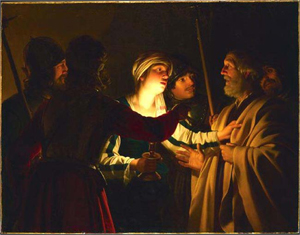
DORE
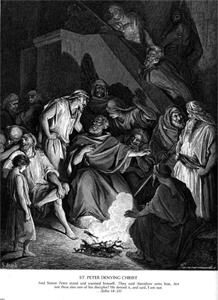
REMBRANDT
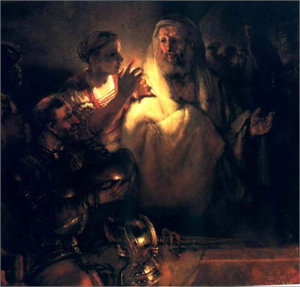
EL GRECO
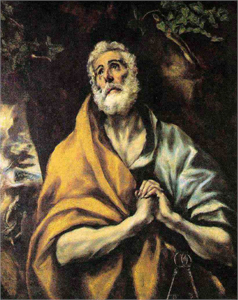
MADIA
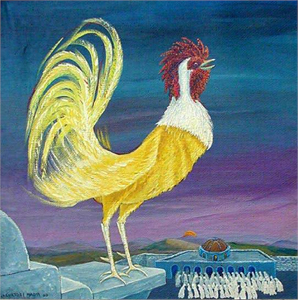
Discusion Question:
What does the story of Peter's denial mean to you? What are the most important facests of the story to you? |
-Now the men who were holding Jesus began to mock him and beat him. They also blindfolded him and kept asking him, ‘Prophesy! Who is it that struck you?’ They kept heaping many other insults on him. In that midnight kangaroo trial, the security guard/police of the chief priests began to mock Jesus and beat him up, taunting and insulting him.
-When day came, the assembly of the elders of the people, both chief priests and scribes, gathered together, and they brought him to their council. It was the morning after. It was Friday morning, early morning.
-Now the chief priests and the whole council were looking for testimony against Jesus to put him to death; but they found none. For many gave false testimony against him, and their testimony did not agree. The whole council was there; that is, all seventy-one members of the Sanhedrin, the Jewish ruling Supreme Court.
-Some stood up and gave false testimony against him, saying, ‘We heard him say, “I will destroy this temple that is made with hands, and in three days I will build another, not made with hands.”’ But even on this point their testimony did not agree. We hear that Jesus had been teaching on two levels. That is, Jesus had taught that the temple (of his body) would be destroyed and then raised again in three days. The chief priests mistakenly thought that Jesus was referring to their physical temple which had been built by Herod the Great. The chief priests thought that Herod’s temple would be destroyed and then raised again in three days. Once again and repeatedly, the chief priests misunderstood Jesus. The chief priests were blind to Jesus’ true identity and were deaf to the meaning of his teachings.
-Then the high priest stood up before them and asked Jesus, ‘Have you no answer? What is it that they testify against you?’ The high priest was Caiaphas, the man who more than any other human, was responsible for the plot to execute Jesus. He had the power, the political clout and the money.
-But he was silent and did not answer. Again the high priest asked him,
-Jesus answered, ‘I have spoken openly to the world; I have always taught in synagogues and in the temple, where all the Jews come together. I have said nothing in secret. Why do you ask me? Ask those who heard what I said to them; they know what I said.’ That is true. Jesus had been openly teaching in the temple for several days and at night he camped out at the Garden of Gethsemane on the Mount of Olives only to return at the break of dawn the next day and continue teaching. We have closely read these stories of Jesus’ teaching in the temple.
-When he had said this, one of the police standing nearby struck Jesus on the face, saying, ‘Is that how you answer the high priest?’ One of the Jewish police who worked for the chief priests hit Jesus on the face. In our imaginations, we can see that hand slapping Jesus’ face and Jesus’ face twisting back as he was hit.
-Jesus answered, ‘If I have spoken wrongly, testify to the wrong. But if I have spoken rightly, why do you strike me?’ Jesus’ brain was always working. Here in this moment when a policeman hit him on the face, Jesus continued to ask his befuddling questions that baffled his tormenters.
- Again the high priest asked him, ‘Are you the Messiah, the Son of the Blessed One?’ Jesus said, “I am and you will see the Son of Man seated at the right hand of the Power, and coming with the clouds of heaven.” This was the crux of the matter. Jesus clearly identified himself with the Son of Man who was to be seated at the right hand of God in the final judgment and then would come again at the end of time, to judge the world. Jesus was crystal clear about his self identity and who he was/is. His words were blasphemy, claiming himself to be God.
-Then the high priest tore his clothes and said, “Why do we still need witnesses? You have heard his blasphemy! What is your decision?” The high priest knew the crime that Jesus had committed: blasphemy.
-All of them condemned him as deserving death.
-Some began to spit on him, to blindfold him, and to strike him, saying to him, ‘Prophesy!’ The guards also took him over and beat him. This scene is repeated again later: soldier’s blindfold Jesus, hit Jesus, and then try to have Jesus guess which one of the guards struck him. Jesus’ clairvoyance bewildered them and so they blindfolded him, hit him and asked Jesus to identify which soldier did the dirty deed. They were mocking his clairvoyance, his knowledge of things that would come to pass before those events occurred.
#334. Jesus Delivered to Pilate
Matthew 27:1-2, Mark 15:1, Luke 23:1, John 18:28
-As soon as it was morning, the chief priests held a consultation with the elders and scribes and the whole council. They bound Jesus, led him away, and handed him over to Pilate. The Jewish leadership knew that they did not have the power of execution but the Romans did. Jesus must be tried and convicted by Pontius Pilate, the Roman governor of their region.
-Then they took Jesus from Caiaphas to Pilate’s headquarters. It was early in the morning. They themselves did not enter the headquarters, so as to avoid ritual defilement and to be able to eat the Passover. (only John) We will study Pilate who operated out of his headquarters in the next lesson.
#335. The Death of Judas
Matthew 27:3-10
In the Passion Story, all four gospels tell almost the same story. The contents of the passion stories are about the same in all four gospels except for this story. This particular scene of Judas hanging himself is reported only in Matthew’s gospel. The phrase, “thirty pieces of silver,” is important to Matthew because it was a fulfilled of Old Testament prophecy from Jeremiah.
-When morning came, all the chief priests and the elders of the people conferred together against Jesus in order to bring about his death. They bound him, led him away, and handed him over to Pilate the governor.
-When Judas, his betrayer, saw that Jesus was condemned, he repented and brought back the thirty pieces of silver to the chief priests and the elders. He said, ‘I have sinned by betraying innocent blood.’ Circle the word, “repented,” and remember that Judas repented of the evil that he had done to Jesus.
-But they said, ‘What is that to us? See to it yourself.’
-Throwing down the pieces of silver in the temple, he departed; and he went and hanged himself. Judas could not forgive himself for what he had done to Jesus. He killed himself. He hung himself.
-But the chief priests, taking the pieces of silver, said, ‘It is not lawful to put them into the treasury, since they are blood money.’ After conferring together, they used them to buy the potter’s field as a place to bury foreigners. For this reason that field has been called the Field of Blood to this day.
-Then was fulfilled what had been spoken through the prophet Jeremiah, “And they took the thirty pieces of silver, the price of the one on whom a price had been set, on whom some of the people of Israel had set a price, and they gave them for the potter’s field, as the Lord commanded me.”
Discussion Question:
Do you think that God forgave Judas? Why or why not? Can a person who commits suicide be forgiven? Why or why not? |
#334, #336. Jesus Delivered to Pilate
The Trial Before Pialate
Matthew 27:1-2, 11-14, Mark 15:1-5, Luke 23:1-5, John 18:28-38
-Then they led Jesus from the house of Caiaphas. (John’s gospel) We remember from earlier lessons that Herod the Great (Herod the Great Builder) had erected several large, grandiose Roman buildings in Jerusalem. We remember that the Romans were fine craftsmen and artisans. These Roman buildings in Jerusalem would have been as opulent as similar buildings in Ephesus and other centers of Roman culture. Unlike Ephesus and Rome, the Roman armies leveled Jerusalem in 70 CE. But during Jesus’ time on earth, there were several grand Roman buildings in Jerusalem. Jesus visited an impressive city.
In the diagram below, identify both the house of Caiaphas and Herod’s palace. It is most likely that Herod’s palace was the official residence of Governor Pontius Pilate when he visited Jerusalem for special occasions such as the Passover feast. Herod’s palace is “the preatorium” in the gospels. This is review from last week.

A person can see models of the Palaces of Caiaphas and Herod in the Holy Land Hotel.

Palace of Caiaphas
This is where informal meetings of a small Sanhedrin were held. Peter denied Jesus in one of these courts. This model at the Holy Land Hotel is a scholar's conception showing how the site may have looked in Jesus' day.
-To the headquarters (the praetorium.) The praetorium “denotes the place of residence of the chief official in the subjugated Roman territory. In Palestine, the Roman governor’s permanent residence was at Caesarea (Acts 23:33-35 which places the Roman governor in the praetorium of Herod.) Here we are concerned with the governor’s residence in Jerusalem, occupied during festivals or in times of trouble. … (The gospels) envision a large building with an outside court where the Jewish crowd would assemble. There would have been inside rooms, including bed chambers (e.g. Pilate’s wife) and barracks for soldiers. … The location of the Jerusalem praetorium is uncertain, but there are two likely candidates, both mentioned by Josephus. 1) The fortress of Antonio and 2) The Herodian Palace on the West hill (today near the Jaffa gate) which dominates the whole city. Herod the Great built this as a more grandiose dwelling and moved here from the Antonio in 23 BC. From the evidence in Josephus and Philo, this served as the usual Jerusalem residence for the Roman procurators.” (Brown, JOHN, V. 2, p. 845.)
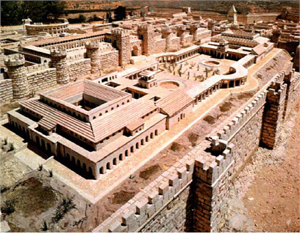
Palace of Herod
“King Herod built a fantastic fortified palace to provide protection for the Upper City. Just like the Temple, Herod's Palace was constructed on a platform, about 1000 feet (from north-south), and 180 feet (from east-west). The Palace consisted of 2 main buildings, each with its banquet halls, baths, and accommodation for hundreds of guests. It was surrounded with groves of trees, canals, and ponds studded with bronze fountains.”
The praetorium of the trial of Jesus was located at Herod's palace which was actually the official residence of the Roman governors when they came to Jerusalem during major Jewish festivals.
Unfortunately, nothing remains of its construction.
This model at the Holy Land Hotel is a scholar's conception showing how the site may have looked in Jesus' day.”
Remember that we are dealing with grandiose Roman architecture and construction. If a person visits Rome or Ephesus today and sees the ruins from the grand Roman culture of the past, a person is overwhelmed by the engineering, architecture and construction of these Romanesque colossal sites. The Roman architecture in Jerusalem was no different. The Jerusalem of Jesus’ day was not a backwater “hick town” but the capitol city of that area of the world. Jerusalem could “boast” of many large Roman buildings erected by the builder of all builders, Herod the Great.
On the above model, focus on the platform which was longer than three football fields. Memorize the grandeur of the building in the model above. It seems to be an accurate representation of the building in which Jesus was tried by the Roman governor and then scourged.
-It was early in the morning. At daybreak. The Roman officials began their work before dawn.
-They themselves did not enter the headquarters (praetorium), so as to avoid ritual defilement and to be able to eat the Passover. “The reference to the coming Passover supper makes it clear that for John, Jesus was tried by Pilate and crucified on the day before Passover.” (Brown, JOHN, V. 2, p. 846).
-So Pilate went out to them and said, ‘What accusation do you bring against this man?’ This is the first mention of Pilate in the book of John. Pontius Pilate’s name would have been known to the early Christians since his name is mentioned it the book of Acts (3:13, 4:27. 13:28) and also in the Apostle’s Creed. “He was of lower nobility as contrasted with senatorial rank. He ruled Judea from 26-36 AD. Judea was a lesser imperial province. … Pilate is usually identified as a procurator. … A reasonable amount about Pilate is known from Jewish writing and the picture is not favorable. Philo attributes to Pilate robbery, murder and inhumanity. Josephus writes vividly of his blunders and atrocities (e.g. the slaughter of the Galileans mentioned in Luke 13:1).” (Brown, JOHN, V. 2, p. 847).
FROM A SERMON
“It is with this mood of rioting, polarizations, and a nation and city torn apart, that we approach the governorship of Pontius Pilate. Pilate was the governor of Jerusalem and Judea. Pontius Pilate, during his ten years as a governor, from the year 26-36 CE, had thirty-two riots. 32 riots in mere ten years. Three major riots a year for ten consecutive years. The Jews hated the Romans. They hated the Roman taxes. They hated the Roman insensitivities to their religion. The Jews of that time were constantly on the edge of rioting, especially the Galileans.
I would like to briefly tell you about three riots during the reign of Pontius Pilate. These reports come from Philo, a Jewish theologian, and Josephus, the Roman historian.
The first riot was like this: The Jews were fanatics about God, and they were absolutely committed to their second commandment, you shall have no graven images of God. Idolatry was the worst of sins; worshipping a graven image, a carved image of God. Carved or crafted images of God were absolutely and totally forbidden. In the year 26 CE, shortly after Pilate become governor, Pontius Pilate came riding into the city of Jerusalem with his troops bearing their standards or flag poles. On the top of every flagpole was a carved image of Caesar, the bust of Caesar. No Roman governor had done this before, parading with a carved image of Caesar. It was a total insult to the Jews, and so a riot began. The Jews first came out by the hundreds and then by the thousands to the home of Pontius Pilate in Jerusalem, and for five days, they staged a sit-in, much like college students stage a sit-in on the college campus, on the front law of the college president. Pilate was infuriated with the protestors. He rounded up some of them into an auditorium and killed several of them. The Jews continued their civil disobedience, passively offering their necks to be sliced. The protests were effective; Pilate backed down; and the busts of Caesar were removed from all the flagpoles. But lives had been killed and this was the first of many more riots to come.
Let me tell you about the second riot that Pilate precipitated. Pilate wanted money to be taken from the temple treasury in order to build a pipeline to bring water into the city of Jerusalem. Like Arizona and California today, Jerusalem had water problems. Jerusalem had to get money in order to build an aqueduct so water could be transported to the city. Where was Pilate going to get the money? He didn’t have federal funds to draw on; he didn’t have any extra tax money sitting around. So Pilate went to the temple treasury, to the sacred money, to the money of Annas and Caiaphas. Pilate stole or borrowed the money from the temple treasury to build his aqueduct, and immediately, the rioting began. This time Pilate ordered his soldiers to dress up as plain-clothes men, secretly to arm themselves and mingle with the rioting mobs. As the signal was given, these Roman soldiers, dressed as civilians, bludgeoned the Jews with their weapons, clubbing and stabbing the Jews to death. Thus another riot was stopped during the reign of Pilate. Pilate, of course, was hated. And the neighboring governors started sending letters to Emperor Tiberius in Rome complaining about Pilate’s brutality in handling the riots. (Again, this useful material comes from Josephus, the historian, and Philo, the Jewish theologian, both writing at this time.)
Let me tell you about the last riot, the 32nd riot under Pilate. This riot was in the year 36 CE in Samaria. A Samaritan told some Jews that he would show them where Moses had hidden sacred relics on a mountain. People were going on a wild goose chase, up to the top of the mountain, looking for a copy of the Ten Commandments, the sacred relics of Moses. The Jews had small arms with them. Pilate, hearing that the Jews were armed, ordered his horsemen to attack and kill the essentially defenseless Jews. It was a bloodbath, a slaughter of innocent people. One neighboring Roman ruler was so upset about Pilate’s slaughtering of the Jews that he sent another letter to Caesar Tiberius in Rome complaining about Pilate. Shortly thereafter, Pilate was removed from office because of his brutal handling of the riots. As Pilate traveled to Rome, Emperor Tiberius died, and we don’t ever know what happened to Pilate. Pilate disappeared into the pages of history; only to have his name repeated every Sunday in our creed, “crucified under Pontius Pilate.” Maybe our creed should have said, “Jesus was crucified under the riots of Pontius Pilate.” Our creed would have been more historically accurate.
Pilate was a person who was sick of rioting, sick of the mobs, sick of a nation torn apart by strife. It is with this awareness of Pilate and his riots that we begin to more clearly understand what happened to Jesus on that Friday morning in Jerusalem.
Pilate had already arrived in Jerusalem with his wife, Procula, and 600 troops. Yes, 600 armed soldiers. The soldiers had come prepared; they were well armed and trained to exercise control if another riot erupted. Normally, Pilate lived in Caesarea on the Coast, but Pilate would come to the capital city, Jerusalem, whenever the city was jammed with potentially rebellious pilgrims. It was Passover time on that particular Thursday and Friday, and there were two-three million people jammed into Jerusalem. So Pilate came from Caesarea by the Sea, his home residence, to Jerusalem with 600 troops and 600 horses, “just in case.”
Thursday night, nothing happened. It was calm that Thursday night, but Friday morning, all hell broke loose. Annas, the old man and power behind the high priest, and Caiaphas, his son-in-law and current chief High Priest, brought Jesus to Pilate. Annas was first high priest, then four of his sons were high priests, and now his son-in-law was high priest. Annas kept the high priestly power in his family. Annas and Caiaphas, the two religious leaders and thugs, brought not only Jesus, but a large mob of shouting, yelling, shrieking Jews who were bent on rioting at the least provocation. Annas and Caiaphas brought their charges against Jesus, telling Pilate that Jesus claimed to be king of the Jews. Annas and Caiaphas stirred up the people into a riotous mood, and falsely said that Jesus forbid the citizens to pay the proper taxes to Caesar. Annas and Caiaphus finally played their trump card when they said: “Pilate, if you are a friend of Caesar, you better execute this revolutionary, this seditionist, this anarchist. Pilate, you better have him killed.”
Pilate then questioned Jesus and found no guilt in him; Jesus was innocent of the charges that the two high priests had brought against him. Pilate saw through the sham; Pilate saw through the scheme of Annas and Caiaphas. Pilate wanted to dismiss the whole affair as a nuisance, but the two powerful high priests incited the crowds to begin rioting. The Bible says, “In order to avoid a riot,” Pilate condemned Jesus to death.
Pilate was caught in the middle and he didn’t like it. There was no neutrality before the cross. There was no middle ground.
When I think of Pilate, he was not like Annas and Caiaphas who blatantly wanted to have Jesus killed. Pilate was not like Judas, who betrayed Jesus for money, greed and material prosperity. Pilate was not like Peter, who denied Jesus at the crucial hour, pretending he never knew Jesus. Pilate was like none of these. Rather, Pilate was one of those people who wanted to remain neutral, who didn’t want to become involved. He wasn’t for Jesus nor was he against Jesus. Pilate was the man in the middle and he wanted to remain the middle where he thought he could save his skin.
There is one basic lesson to be learned from Pilate: Before the cross of Christ, there is no neutrality. The cross of Christ always demands a decision. Pilate, during the trial, asked, “What shall I do with Jesus?” There was no middle ground. Either he was to cast his lot for Christ or against him. The cross does that. During the whole passion narrative, the cross forces people into a decision. People had to make a choice, either to be for Christ or against him. There was no neutrality.
Let me give you some examples of this. The eleven disciples. When Jesus was arrested in the garden, the disciples had to make a decision, either to be crucified with Jesus or to run away. The disciples made a decision: they ran. There was no neutrality.
Or, Simon Peter out in the courtyard at the home of Caiaphas. A maid asked Peter the question: “Are you one of the Galileans or not?” Peter had to make a decision. “I am not,” he said. Again, there was no neutrality.
Or, two men were on the cross on either side of Jesus at Golgotha. One criminal made a decision to ridicule Jesus; the other criminal made a different decision and said, “Remember me when you come into your kingly power.” Again, there was no neutrality.
It is the nature of the cross that compels us to make a choice, whether a person has to make a snap decision or a slow decision. There is something about the cross that compels us to make a choice, either for him or against him. You can’t find a middle ground when it comes to Christ, even though at times we try to.
This is clearly expressed in a poem:
‘I stood alone at the cross of Christ,
In the hush of twilight dim,
And faced the question
That pierced my heart,
What shall I do with him?
Crown or crucify, what shall it be?
No other choice is offered me.’”
End of sermon.
-They answered, ‘If this man were not a criminal, we would not have handed him over to you.’ The Jewish authorities knew that only the Romans had the power to execute Jesus.
-Pilate said to them, ‘Take him yourselves and judge him according to your law.’ Pilate knew the Roman law and Jewish law. Pilate didn’t want to get involved in this mess. He didn’t want to get involved with an “in house” squabble among the Jews.
- The Jews replied, ‘We are not permitted to put anyone to death.’ (This was to fulfill what Jesus had said when he indicated the kind of death he was to die.) The phrase, “the Jews” is a summarization of all those Jewish leaders who were hostile to Jesus e.g. the elders, scribes, Pharisees, Sadducees and others in positions of governing authority.
Jesus knew by what kind of death he was going to die. He had prophesied that he was to “be lifted up” and to be “lifted up” meant to be “lifted up” onto a cross, which was the Roman means of execution.
The Roman government retained the power to execute. That is one primary way that the Romans retained political power in their provinces.
“A death penalty could not be executed unless Rome issued it (Josephus Jewish Wars 2.8.1 117; Jn 18:31). So the leadership takes Jesus to Pilate. The charges must be formulated in a way that causes Pilate, as procurator and protector of Roman regional concerns, to be worried about his future as governor if he does not stop Jesus. (Kinman 1991).” - They began to accuse him, saying, ‘We found this man perverting our nation, forbidding us to pay taxes to the emperor, and saying that he himself is the Messiah, a king.’ Then Pilate asked him, ‘Are you the king of the Jews?’ He answered, ‘You say so.’ (Only Luke) The Jewish leaders wanted to frame Jesus, so that he would be executed. The charges that needed to be brought against Jesus was that he was a revolutionary, and not loyal to Caesar. We recall that Pilate had faced thirty-two riots in his term in office and he knew first hand the political pandemonium associated with revolutionaries.
"He opposes payment of taxes to Caesar." This charge concerning the poll tax is patently false, as 20:25 has already shown. But the charge is clever, because Pilate's major political responsibility is the collection of taxes for Rome. A second element in the charge is also a source of concern. The taxes go to Caesar, raising the issue of Pilate's personal loyalty or disloyalty. Failure to act against one who opposes Caesar would mean one is not a friend of Caesar either. Servants of Rome unfaithful to Caesar are not servants for long!”
-Then Pilate entered the headquarters again, summoned Jesus, and asked him, ‘Are you the King of the Jews?’ In the Gospel of Jesus, we find Pilate going in and out of his headquarters. Pilate ordered Jesus into his palace. All four gospels have Pilate asking that same question: “Are you king of the Jews?” Perhaps there was a lingering memory within Pilate’s mind of the Maccabean revolt from years before and the Jewish masses hoping for a political liberator. Such was the mood from the Palm Sunday parade a few days earlier when the masses were calling for a new messiah, a new liberator to free them from the oppression and insensitivities of the Roman occupiers of the land.
-Jesus answered, ‘Do you ask this on your own, or did others tell you about me?’
-Pilate replied, ‘I am not a Jew, am I? Your own nation and the chief priests have handed you over to me. What have you done?’
-Jesus answered, ‘My kingdom is not from this world. Circle this phrase. Underline it. Highlight it. Memorize it. God/Christ is to rule our lives but this reign of God over our hearts and habits is not like the earthly reign of kings. The “kingdom” is Jesus’ primary teaching in the first three gospels. There are miracles of the kingdom, parables of the kingdom, teachings of the kingdom. The kingdom is where ever God/Christ rules in our hearts, lives or our communities.
FROM A SERMON
“I would like to suggest to you that this king and the spirit of his kingdom lives on and are the strongest force in the world. This kingdom will be forever challenged but never defeated.
All kings die. All presidents die. All dictators die. Every one of them has died and few of them are remembered. In the thousands of years of history, their names are already or will be gone, disappeared, forgotten, but there will be one king...one name that will continue. The spirit of his kingdom is alive today as much as it was 2000 years ago.
The great nations will rise and fall. Think of the great nations today. The United States, Russia, China, Germany, France, England, Japan, and in two thousand years from now, their names will be like Pamphilia, Gad, and Silica. For all the great nations which are so powerful today have their nanosecond in history, and are gone and their names are barely remembered. The spirit of God’s kingdom will live and shine when all these kingdoms of the earth have since passed away.
What I am suggesting to you is that “they” attempt to execute Jesus in every generation, but no one has been able to kill the king. No one has been able to kill the spirit of his kingdom. Kings have come and gone, and kingdoms have come and gone; and intellectuals have come and gone. All of them have at one time challenged this king with their weapons or intellect, and then, they have all died. But THE king? THE king and the spirit of his kingdom live on into God’s eternal future. You see, the king is the Spirit of the Living God and there is no earthly king, no nation, no skeptic who in any way compares to the everlasting king, the ruling Spirit of the Living God.”
-If my kingdom were from this world, my followers would be fighting to keep me from being handed over to the Jews. But as it is, my kingdom is not from here.’
-Pilate asked him, ‘So you are a king?’ Pilate is interested in this line of questioning. Pilate wants to know if Jesus is really a threat to him.
-Jesus answered, ‘You say that I am a king.
-For this I was born, and for this I came into the world, to testify to the truth. Everyone who belongs to the truth listens to my voice.’ Jesus’ life had a fundamental purpose and destiny: to witness to the truth. Jesus has come into the world to testify that he wants to rule the hearts and habits of human beings, the minds and movements of our daily lives. That is the truth: Jesus wants to rule our hearts and lives. Jesus wants to be THE Lord of our lives. That was and is the destiny of Jesus.
We, the follower of Jesus, know his voice and listen to his voice, as sheep know and listen to the voice of their shepherd. The mark of a loyal disciple is listening, listening to the words of Jesus. We recall the contrast between Mary and Martha. Martha was distracted and worried about many things. Meanwhile, Mary sat at the feet of Jesus and listened to him. The disciples of Jesus listen to his voice.
-Pilate asked him, ‘What is truth?’ Circle, highlight, memorize. We remember Pilate for many reasons and one reason we remember him is because of this fundamental question: “What is truth?” Standing in front of Pilate was Jesus who was/is the embodiment of truth. Jesus spoke the truth: the truth that there is a personal God; the truth that God is a loving Father; the truth that God knows the numbers of hairs on our heads; the truth that the great commandments of God are to love God and our neighbor as ourselves. Jesus embodied the truth about God and the way that we human beings are to live and love. What is truth? Look at Jesus, listen to his voice, and see who he is and you will discover the Truth about God and your own life.
-After he had said this, he went out to the Jews again and told them, ‘I find no case against him. Three times in the Gospel of John we hear that Jesus was declared “not guilty.” (In John 19: 4, 6). Jesus was also declared “not guilty” three times in the Gospel of Luke also. (Luke 23: 4, 14 22).
#337. Jesus Before Herod
Luke 23:6-12
This section of the Passion Story is only found in Luke’s gospel.
-But they were insistent and said, ‘He stirs up the people by teaching throughout all Judea, from Galilee where he began even to this place.’
-When Pilate heard this, he asked whether the man was a Galilean. It was as if Pilate learned for the first time that Jesus was a Galilean who had begun his ministry preaching and teaching in the province of Galilee, which was a hotbed for many political revolutionaries.
-And when he learned that he was under Herod’s jurisdiction, he sent him off to Herod, who was himself in Jerusalem at that time. We remember Herod Antipas from our previous studies. There are thirteen references to Herod Antipas in the Gospel of Luke. See P. 133 in our text, #143-144. That is, Herod was the ruler who had John the Baptist beheaded. Herod had heard about the fame of Jesus. Herod had immorally and illegally married his brother’s wife, Herodias. See also P. 190, #212, Luke 13:31 when the Pharisees said to Jesus, “Get away from here for Herod wants to kill you.”
When Herod the Great died in the year 4 BCE, he divided his kingdom among his sons. Herod the Tetrarch was one of those sons. Tetrarch means four or the ruler of one of the four parts. He was also known as Herod Antipas, and he ruled Galilee and Peraea. We learn about this Herod Antipas from the Bible but also from Josephus in his book, THE ANTIQUITY OF THE JEWS.
“Because of the holiday season, Herod himself is also in Jerusalem--a coincidence of divine proportions--staying at a beautiful palace west of the temple (Josephus Jewish Wars 2.16.3 344; 5.4.4 176-83). When Jesus is brought before him, Herod hopes for a show, for he has been longing to see Jesus work miracles. But Jesus is not an entertainer given to fulfilling curiosity.”
This, then, was the fourth trial of Jesus. The four trials of Jesus were:
- Before the Jewish Sanhedrin late Thursday night;
- Before Pilate early Friday morning;
- Before Herod Friday morning.
- After a brief time before Herod, Jesus was then brought back to face Pilate again.
-When Herod saw Jesus, he was very glad, for he had been wanting to see him for a long time, because he had heard about him and was hoping to see him perform some sign. For Herod, Jesus was a circus sideshow, a performer of religious tricks, a happy Houdini from the Holy Land. Herod wanted to see a religious show and demonstration of miraculous signs. Jesus had made his reputation in Herod’s province of Galilee by doing such signs and miracles. Herod had only heard the stories about Jesus but had never seen the man in action. Here was his chance for divine entertainment.
The movie, THE PASSION, created a wonderful scene about Herod who wanted to see Jesus perform a sign or miracle.
He questioned him at some length, but Jesus gave him no answer. Herod kept on hammering away his questions at Jesus. By speaking no words, Jesus seems to be fulfilling a prophecy from Isaiah 53:7 that became meaningful in the Church: “He was oppressed and he was afflicted , yet he opened not his mouth; like a lamb that is led to the slaughter and like a sheep that before its shearers is silent, so he opened not his mouth.”
-The chief priests and the scribes stood by, vehemently accusing him. The chief priests and scribes joined in the fervor of the moment, intensely accusing Jesus of many crimes.
-Even Herod with his soldiers treated him with contempt and mocked him; then he put an elegant robe on him, and sent him back to Pilate. This same mocking of Jesus as being some sort of king occurred the night before in the house of Caiaphas, the high priest. This was the second beating of Jesus.
-That same day Herod and Pilate became friends with each other; before this they had been enemies. We do not know the source of conflict between Herod and Pilate. Perhaps Pilate’s killing of thirteen Galileans (Herod’s subjects) in the temple (Luke 13:31-33) made Herod angry. But Pilate and Herod became united in their disdain for Jesus. (Best, LUKE, V. 2, p. 902).
#338. Pilate Declares Jesus Innocent
Luke 23:13-16
This scene is only found in the Gospel of Luke.
-Pilate then called together the chief priests, the leaders, and the people. For the first time in the story, the people clearly turn against Jesus. Previously, it was always and only the leaders who were against Jesus and tried to find schemes to kill him. But now, the people began turning against Jesus.
“In many ways the passion account's real turning point occurs here. Until this point, the common people have been strongly supportive of Jesus. On a few occasions the leadership had found it prudent not to carry out its threats against Jesus because of the people (20:19; 22:2). But now the people react against Jesus, stopping Pilate's attempt to release him.”
-And said to them, ‘You brought me this man as one who was perverting the people; and here I have examined him in your presence and have not found this man guilty of any of your charges against him.
-Neither has Herod, for he sent him back to us. Indeed, he has done nothing to deserve death. “Pilate regards Jesus as not worthy of death but still does not grant him freedom. Two leaders have acquitted Jesus, but that is not enough. The Jewish teacher has become a political football. In a crazy game, a murderer is released and a deliverer is slain.” (Bible Gateway.)
So two Roman leaders, Pilate and Herod, found Jesus innocent of the false accusations of Jesus’ being a king. We remember that the Gospel of Luke was written to Theophilus, a Roman official, and that one of the purposes of Luke’s gospel was to convince people/Gentiles in the Roman world that Jesus can be the Lord/King of their lives. It seems that Luke wanted Theophilis to know that Jesus was declared innocent by two Roman authorities. Jesus was/is not a political insurrectionist. Jesus clearly said, “My kingdom is not of this world.”
-I will therefore have him flogged and release him.’ “Pilate proposes a compromise: he will beat Jesus and then release him. The beating would be either the less severe fustigata or the dreaded verberatio, which would leave one on the edge of death. In either case, the whip used possessed short teeth that would cut the skin and lead to bleeding. Pilate supposes that punishment would deter the teacher and calm the leadership. But no compromise can be found. When the decision comes for Jesus to be crucified, he receives the heavier beating, the verberatio, since it prepares the victim for crucifixion and makes death come more quickly.”
This will be the third beating of Jesus. The first was by the chief priest’s police (p. 303); the second by Herod’s troops; the third by Pilate’s soldiers.
#339. Jesus or Barabbas?
Matthew 27:15-23, Mark 15:6-14, Luke 23:17-23, John 18:39-40
The following is a harmonization of the gospel accounts of this event.
-Now at the festival he used to release a prisoner for them, anyone for whom they asked. It seems that it was an annual custom at Passover that the governor would release one prisoner of the crowd’s choosing. There is no historical record of such a procedure in Roman law, so this appears to be a local custom in Jerusalem at the Passover.
-Now a man called Barabbas was in prison with the rebels who had committed murder during the insurrection. Notice the footnote at the bottom of the page, “k”. The footnote says that in certain manuscripts, Barabbas had a first name and his first name was Jesus. So Pilate was giving the crowd a choice of Jesus Barabbas or Jesus the Christ. This Jesus Barabbas was in prison and had been part of the numerous insurrections in Jerusalem. This Jesus Barabbas had killed a person/persons during riots in the city.
-So the crowd came and began to ask Pilate to do for them according to his custom. Circle the word, “crowd,” and focus your attention to the masses. In this scene, we feel the presence of the crowd, the power of the mob. Five days before, this same crowd was chanting wildly for Jesus as he rode into the city on a young jackass, but now the fickle crowd had turned hostile against Jesus. Why the sudden change? Why had Jesus become such a disappointment to the masses? The Scriptures don’t tell us. What is your conjecture? Were they disappointed that Jesus was not the political messiah that they were looking for?
-Then he answered them, ‘Do you want me to release for you the King of the Jews?’ A reader can feel the sarcasm in Pilate’s voice. Jesus did not look like a king, act like a king, or use power like a king. If anything, Jesus was a parody of what an earthly king was to be.
-For he realized that it was out of jealousy that the chief priests had handed him over. Circle the word, “jealousy.” Pilate knew the real reason that the chief priests wanted to get ride of Jesus.
- While he was sitting on the judgment seat, his wife sent word to him, ‘Have nothing to do with that innocent man, for today I have suffered a great deal because of a dream about him.’ (Matthew only) Circle the word, “wife,” and write the name, “Procula.” Also write, “She was the granddaughter of Caesar Augustus.” Procula is the only Roman woman we find in the gospel stories. A tradition is that Procula became a Christian and the Greek Orthodox Church assigns her a feast day on October 27th. Procula plays a major role in the film, THE PASSION.
http://www.4thpres.org/archivernserm/072802rn.htm
“During a stay in Rome Pilate met and married Claudia Procula, the illegitimate daughter of Claudia, the third wife of the Emperor, Tiberius. She was the granddaughter of Augustus Caesar.
This connection with the ruling house served Pilate’s personal interests in an unexpected degree; in AD26, on the recommendation of Sejanus, the Emperor’s right-hand man, he was appointed Procurator of Judea. In accepting the post, he applied for and obtained the very unusual privilege of taking his wife with him. Wives did not normally accompany their husbands to the provinces. That she wanted to be with her husband in Judea and in Jerusalem at a time of turbulence indicates that she and Pilate had a relationship that was closer than usual. Her intervention in the trial of Jesus is an action of grace in a day that was clouded by sorrow. We know little about her, but what we do know indicates that she was a remarkable woman:
She is the only Roman woman spoken of in the four gospels. She is the only woman of high rank who was in any way affected by Jesus. She seems to have had the confidence of her husband, or she would not have dared to intervene in a trial where he was the representative of Rome and judge in the case. She had been sufficiently impressed by Jesus to dream about Him. She knew Jesus well enough to pass a penetrating judgment upon Him. She had the courage to forget the repercussions that it might have on her and send the one sentence message to her husband.”
Why did Matthew insert this vignette about Herod’s wife? We don’t know. It is consistent with Matthew’s positive appreciation of God revealing himself through dreams that we see often in Matthew’ gospel. We remember the story about the wise men being warned in a dream and Joseph also being warned in a dream. The theme of “being warned in a dream” is important to Matthew.
-But the chief priests stirred up the crowd to have him release Barabbas for them instead. The power was in the crowds. The chief priests sensed that they could stir up the crowds against Jesus.
-Pilate spoke to them again, ‘Then what do you wish me to do with the man you call the King of the Jews?’ Write the phrase, “This is the big question.” This is the most important question for our lives: “What shall I do with Jesus?” As was said previously in a sermon on this text, Pilate wanted to remain in the middle. He wanted to be the man in the middle and not make a decision for or against Jesus. We often want to play the same role. But often in life, the situation demands that we make a decision, either for Christ or against him. Too often, we want to retreat to the safety of the middle.
-They shouted back, ‘Crucify him!’ Pilate had the power to crucify. The crowds had the power to make Pilate afraid of another riot.
-Pilate asked them, ‘Why, what evil has he done?’ Pilate is keenly aware that Jesus was innocent. So was Herod. The two highest Roman officials at the scene of the crime knew the innocence of Jesus.
- A third time he said to them, ‘Why, what evil has he done? I have found in him no ground for the sentence of death; I will therefore have him flogged and then release him.’ But they kept urgently demanding with loud shouts that he should be crucified; and their voices prevailed. (only Luke). Luke is addressing Theophilus, a Roman official, and it seems that Luke wants to make it very clear that the Roman governor, Pilate, found no crime in Jesus. It was the crowd, the mob, and the masses that put pressure on Pilate who succumbed to their fanatical desires.
-But they shouted all the more, ‘Crucify him!’
Discussion Question:
In your opinion, why did the enthusiastic crowds of Palm Sunday become the crucifying crowds of Good Friday?
|

 Back to Top Back to Top
|










